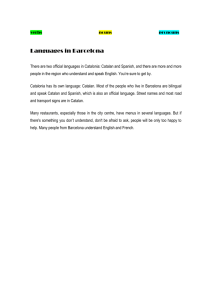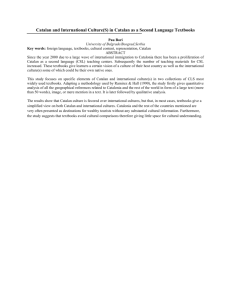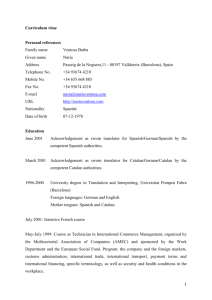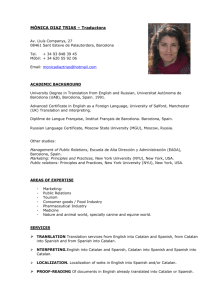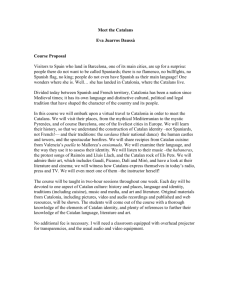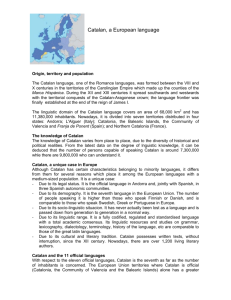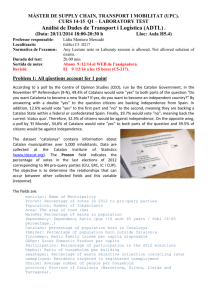N-words in Catalan and Spanish
advertisement
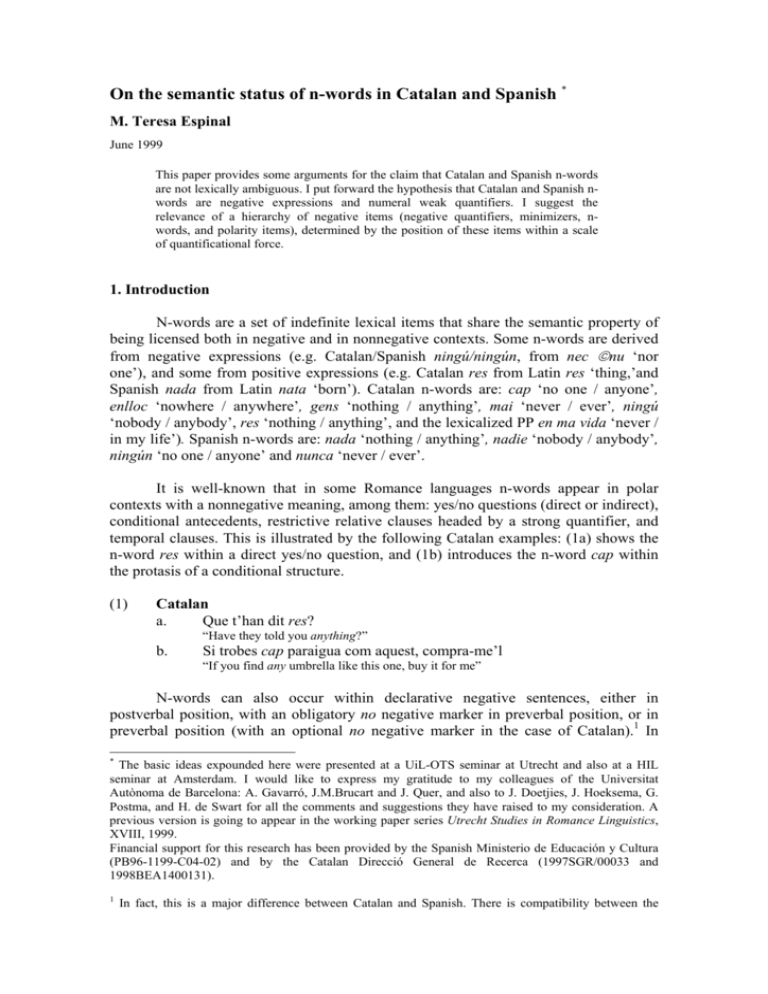
On the semantic status of n-words in Catalan and Spanish * M. Teresa Espinal June 1999 This paper provides some arguments for the claim that Catalan and Spanish n-words are not lexically ambiguous. I put forward the hypothesis that Catalan and Spanish nwords are negative expressions and numeral weak quantifiers. I suggest the relevance of a hierarchy of negative items (negative quantifiers, minimizers, nwords, and polarity items), determined by the position of these items within a scale of quantificational force. 1. Introduction N-words are a set of indefinite lexical items that share the semantic property of being licensed both in negative and in nonnegative contexts. Some n-words are derived from negative expressions (e.g. Catalan/Spanish ningú/ningún, from nec nu ‘nor one’), and some from positive expressions (e.g. Catalan res from Latin res ‘thing,’and Spanish nada from Latin nata ‘born’). Catalan n-words are: cap ‘no one / anyone’, enlloc ‘nowhere / anywhere’, gens ‘nothing / anything’, mai ‘never / ever’, ningú ‘nobody / anybody’, res ‘nothing / anything’, and the lexicalized PP en ma vida ‘never / in my life’). Spanish n-words are: nada ‘nothing / anything’, nadie ‘nobody / anybody’, ningún ‘no one / anyone’ and nunca ‘never / ever’. It is well-known that in some Romance languages n-words appear in polar contexts with a nonnegative meaning, among them: yes/no questions (direct or indirect), conditional antecedents, restrictive relative clauses headed by a strong quantifier, and temporal clauses. This is illustrated by the following Catalan examples: (1a) shows the n-word res within a direct yes/no question, and (1b) introduces the n-word cap within the protasis of a conditional structure. (1) Catalan a. Que t’han dit res? “Have they told you anything?” b. Si trobes cap paraigua com aquest, compra-me’l “If you find any umbrella like this one, buy it for me” N-words can also occur within declarative negative sentences, either in postverbal position, with an obligatory no negative marker in preverbal position, or in preverbal position (with an optional no negative marker in the case of Catalan).1 In * The basic ideas expounded here were presented at a UiL-OTS seminar at Utrecht and also at a HIL seminar at Amsterdam. I would like to express my gratitude to my colleagues of the Universitat Autònoma de Barcelona: A. Gavarró, J.M.Brucart and J. Quer, and also to J. Doetjies, J. Hoeksema, G. Postma, and H. de Swart for all the comments and suggestions they have raised to my consideration. A previous version is going to appear in the working paper series Utrecht Studies in Romance Linguistics, XVIII, 1999. Financial support for this research has been provided by the Spanish Ministerio de Educación y Cultura (PB96-1199-C04-02) and by the Catalan Direcció General de Recerca (1997SGR/00033 and 1998BEA1400131). 1 In fact, this is a major difference between Catalan and Spanish. There is compatibility between the 2 these structures, known as negative concord structures (NC; see the examples in (2)) there seems to be an agreement effect between the negative marker and the n-words or between the n-words themselves.2 (2) Catalan a. No ha vist ningú “(S)he has not seen anybody” (not...nobody) b. Ningú (no) ha vist res “Nobody has seen anything” (nobody not...nothing) c. A NINGÚ (no) ha vist “(S)he has seen nobody” (nobody not) N-words can also occur in the context of a trigger of expletive negation (EN).3 Interestingly, in this context n-words can be licensed with a nonnegative value (compare the expletiveness of ningú / nadie in (3b) to the expletiveness of the negative marker in (3a)), and they can also be licensed with a negative meaning (when n-words cooccur with the negative marker within a NC structure, as in (3c)). The following Catalan examples, with the corresponding standard Spanish form, are relevant in order to illustrate these claims. (3) Catalan / Spanish a. Dubto que no mengi (EN) “I doubt whether he eats” (doubt...not) b. Dudo que coma Dubto que ningú sàpiga la solució del problema (EN) “I doubt whether anybody knows the solution to this problem” (doubt...nobody) c. Dudo que nadie sepa la solución del problema Dubto que ningú no sàpiga la solució del problema (NC) “I doubt that nobody knows the solution to this problem” (doubt...anybody not) Dudo que haya alguien que no sepa la solución del problema The existence of this sort of phenomena raises the interesting question of which is the semantic nature of n-words in these languages, whether they are negative polarity items (Bosque 1980, Laka 1990), negative quantifiers (Zanuttini 1991, Haegemannegative item (negative quantifiers, minimizers or n-words) and the negative head no in preverbal position in Catalan, but not in standard Spanish. See Solà (1973) and Espinal (1991, 1999, forthcoming) for a description of negation in Catalan; see Bosque (1980), Llorens (1929) and Sánchez (in press) for a description of negation in Spanish. 2 NC is a phenomenon of multiple negation, according to which a combination of various negative constituents within a single clause (either a negative marker plus one or several n-words, or a negative marker plus a ni minimizer expression, or a combination of n-words and minimizers in pre and postverbal positions) is indicating that the clause must be interpreted negatively, but at the level of LF one single negation must be licensed. 3 By the term EN, several authors (Vendryes 1950, Martin 1984, Muller 1991) refer to an expletive use of negation, in the sense that within a given structure there is a negative item (usually, the marker of sentential negation) which does not modify the truth value of the proposition in which it appears. I would say (following previous work, Espinal 1992) that EN is a semantic effect obtained at the level of LF when the negative property of specific syntactic constituents (either the negative marker no, or an nword) occuring within some very specific syntactic conditions is absorbed by the logical especifications of another expression provided within the context. In (3) the verbs dubtar / dudar ‘doubt’ would be the triggers of EN. 3 Zanuttini 1991), or negative indefinites (Acquaviva 1993, Ladusaw 1992). It also raises de question of which are the negative and non-negative licensing conditions of negative items (Quer 1993, 1998; Giannakidou-Quer 1997). In order to provide an answer to the first question, which is the immediate goal of this paper, several tests -listed in (4)- have been considered in the literature (Horn 1972; Hoeksema 1983; Laka 1990, 1993; Quer 1993; Zanuttini 1991). (4) a. b. c. d. ability to occur in isolation ability to be modified by almost or absolutely ability to occur in preverbal position ability to appear in polar contexts with a nonnegative value (yes/no questions, conditional if clauses) Having recourse to these tests, Vallduví (1994:270-280) was able to provide a detailed comparison between the syntactic behavior of n-words, minimizers, and polarity items (henceforth PI) in Catalan and Spanish. His results are shown in tables (5) and (6). (5) Catalan (Vallduví 1994:275) a b c yes yes yes yes yes yes no no no d yes no yes (Vallduví 1994:280) a b c n-words yes yes yes min. (+ ni) yes yes yes min. (- ni; N alguno) no no no d no no yes n-words minimizers PI (gaire) (6) Spanish According to tests a,b,c, n-words in both languages behave like minimizers, which seems to suggest that they are fully negative expressions. On the other hand, if we consider test d, Catalan n-words (see the data in (1)) share the ability to occur in non-negative polar contexts with polarity items, which suggests that they are nonnegative expressions. Therefore, two different interpretations of n-words appear to coexist. In fact, it is worth noting that the issue of the interpretation of n-words has received considerable attention in the literature. I will mainly focus on two different hypotheses, which -following Vallduví (1994)- will be named Hypothesis A and Hypothesis B. Hypothesis A basically claims that n-words are negative universal quantifiers, whereas Hypothesis B claims that they are nonnegative existential quantifiers. (7) a. Hypothesis A. (Zanuttini 1991, Haegeman-Zanuttini 1991) N-words are inherently negative expressions which have the properties of universal quantifiers: [∀x ¬]. Syntactically, these n-words are affected by an explicit (or implicit) movement, which raises them to the specifier 4 position of the NegP functional projection. At the level of LF representation these n-words are involved in an absorption operation according to which, when a negative operator has scope over a number of variables, then there is a concord effect which cancels the negative meaning. The well-formedness condition which controls this NC effect is the NEG Criterion. b. Hypothesis B. (Bosque 1980, 1994; Laka (1990, 1993) N-words are negative polarity items which are licensed only under an operator-variable structure. Postverbal NPI require a negation or a negative trigger at preverbal position, so that they are interpreted as polarity items bound to a negative operator: [¬ ∃x]. All NPI are moved to the specifier position of the phrase headed by negation. This movement takes place, either at the syntax or at LF, in such a way that all NPI are interpreted as preverbal constituents at a certain level of analysis. NC is conceived as a polarity construction. Hypothesis A seems to account for the behavior of n-words and minimizers with regard to properties a,b,c, whereas Hypothesis B accounts easily for the behavior of Catalan n-words and polarity items with regard to test d. This leads Vallduví to conclude that Catalan, but not Spanish, n-words are ambiguous between a negative universal quantifier reading and a nonnegative existential quantifier interpretation.4 However, if n-words are considered as negative universal quantifiers it is hard to explain how they can ever get an expletive reading. On the other hand, following hypothesis B, the eventual quantificational force (hereafter, QF) associated with these items (Diesing 1992) remains unexplained. In this paper I would like to put forward the hypothesis that n-words are not ambiguous from the point of view of logical-semantics, and that both in Catalan and Spanish they are negative expressions and numeral weak quantifiers, which means that n-words have a specified negative property and an underspecified QF. In this respect they show a strong contrast, not with minimizers, with which they share both properties,5 but with negative quantifiers (such as Catalan no pas ‘not, not even’) on the one hand, and with polarity items (such as Catalan gaire ‘much / many / very’, minimizers without ni and the N+ alguno ‘some’ structure in Spanish) on the other hand. Furthermore, I shall claim that n-words’ properties are semantically dependent. Consequently, they can be absorbed or made prominent under appropriate structural environments. 2. The analysis The definition of n-words I am going to argue for is given in (8). 4 See also Ladusaw (1992) for analysis of n-words in terms of lexical ambiguity. By contrast, Quer (1993, 1998) defends “a minimal hypothesis according to which the negative items under study are one and the same lexical item, the apparent split in behaviour and interpretation stemming from the differences in their licensing contexts” (Quer 1998:254). 5 I shall come back to the distinction between n-words and minimizers below. 5 (8) Hypothesis C6 a. N-words are indefinite expressions which are incorporated into a numeral meaning º0º b. N-words are weak quantifiers: indefinite terms which allow a varying QF The first part of the definition basically claims that Catalan and Spanish n-words are negative: they are a set of noun expressions which are incorporated into a numeral meaning zero. This means that they are not variables, they are predicates of cardinality zero: zero persons (as in the case of ningú / ningún ‘nobody’), zero things (in the case of cap / nada ‘nothing’), zero places (in the case of enlloc ‘nowhere’), zero amount (in the case of gens / nada ‘nothing’) and zero times (in the case of mai / nunca ‘never’, en ma vida / en mi vida ‘in my life’). Following Déprez (1997), (9a) would be the syntactic structure of ningú and (9b) its corresponding semantic value. (9) a. b. [DP [NumP ningúi [NP ti ]]] 7 ºningúº = º0º(x) [x = persons] In what follows I shall present several arguments that support the two claims expressed in Hypothesis C. Let us first consider some arguments for the negative status of n-words. Arg.1. This is based on the fact that n-words can license, like the negative marker no does, ni minimizers in postverbal position (e.g. Catalan ni un duro in (10a), and Spanish ni una palabra in (10b)). Contrast the grammaticality of the (a,b) examples, with the ungrammaticality of the (c) examples. (10) Catalan a. No tinc ni un duro “I don’t have a cent to my name” (not...not a cent) b. Ningú té ni un duro “Nobody has a red cent” (nobody...not a cent) c. *Tinc ni un duro have not a cent 6 This hypothesis follows ideas suggested by Déprez (1997), who proposes: 1) that N-words are indefinite DPs with varying quantificational force, and 2) that crosslinguistic variations are deductible from the differing internal syntactic and semantic properties of n-words, rather than from differences in the structure of the NegP. The main depart from Déprez’s work is that she holds that French and Haitian creole n-words are nonnegative expressions, whereas I submit the hypothesis that Catalan and Spanish nwords are negative. More recently, Ísac (1999) has also defended the idea that the contrast between NC and non-NC languages 1) does not depend on the (syntactic) properties of the NegP, but strictly on the differing properties of the n-words employed in a language; 2) this difference depends on the +/- quantificational nature of the n-words employed; and 3) depends on the adnominal vs. non-adnominal nature of the (negative) quantifier contributed by the n-word. See Doetjes (1997) for this last distinction. 7 Alternatively, following Danon’s (1996) analysis of bare numerals, the syntactic structure of ningú could be assumed to take the structure in (i): (i) [DP [D ningúi ] [NP [N ti ]]] 6 (11) Spanish a. No dijo ni una palabra “(S)he didn’t say a single word” (not...not a word) b. Nadie dijo ni una palabra “Nobody said a single word” (nobody...not a word) c. *Dijo ni una palabra said not a word This argument is specially relevant if we have in mind that ni minimizers cannot be licensed in polar contexts, that is, in contexts of the type of yes / no questions, and conditional antecedents. (This distribution is recorded in the d column of tables (5) and (6)). Arg.2. It is based on data from the Roussillon Catalan dialect, which show that n-words can appear in postverbal position of negative declarative sentences without a preverbal no negative marker.8 (12) Dialectal Catalan a. Jo he vist ningú “I saw nobody” b. He menjat res “I ate nothing” c. En parla mai “(S)he never talks about it” Arg. 3. This argument is based on the existence of a contrast of meaning between a sentence with a nonspecific indefinite expression within the scope of negation and a sentence with an n-word in the same structural position. Compare the two examples that follow. (13) Catalan a. Ningú no ens ha donat una explicació “Nobody gave an explanation to us” (nobody...a) b. Ningú no ens ha donat cap explicació “Nobody gave any explanation to us” (nobody...any) Although truthconditionally equivalent, (13a) and (13b) have a difference in interpretation, due to the fact that they contain different types of quantifiers, either an nword combined with an existential quantifier or two n-words. Their respective meanings could be represented as in (14a) and (14b), and be paraphrased as follows: (13a) means that there are zero x, x being people, such that it is not the case that there is a y, y being explanations, and x and y are in a giving relation to us; (13b) means that there are zero pairs of people and explanations in a giving relation to us.9 (14) 8 9 a. º0º(x) (persons x) ¬∃ y (explanations y) (x gave y to us) I owe these examples to Gemma Rigau, personal communication. This suggests that a logical procedure of unification of numeral quantifiers (May 1989) should apply to a structure with identical quantifiers, and hence account for the concord reading of (13b). However, this syntactic mechanism cannot account for the interpretation of (13a). See Reinhart (1995, 1997, 1998) for a study of quantifier scope in terms of quantifier raising and choice functions. 7 b. º0º< x,y > (persons x, explanations y) (x gave y to us) The next step is to consider some arguments for the quantificational status of nwords. Arg. 1. The first argument is based on the fact that, as other weak quantifiers (e.g. cardinal numerals and existentials), but in sharp contrast with universal quantifiers, nwords can combine with the additive degree quantifier més ‘more, else’. This argument strongly suggests that n-words are not universal quantifiers. Compare the grammaticality of (15a,b,c) with the ungrammaticality of (15d). (15) Catalan a. No convidis ningú més a la festa “Dont’t invite anybody else to the party” (not...nobody else) b. Pots convidar dues persones més, però no tres més “You can invite two more people, but not three” c. Convida algú més a la festa “Invite somebody else to the party” d. *Convida’n ambdues / totes més invite both / all more Arg. 2. This is based on the fact that, being weak quantifiers, n-words can have both a presuppositional and a non-presuppositional (or cardinal) reading, depending on the existence within the sentence of some semantic and syntactic properties which determine an exact implementation of the QF property of the indefinite.10 The examples in (16) show that n-words may have a presuppositional reading, in which case (i) they presuppose the existence of entities over which a predication is made, (ii) they have a manifested QF (which must be dissociated from a universal reading),11 and (iii) they do not require a quantifier raising operation, that is, they can stay in situ (as illustrated in (16c); Reinhart 1997, 1998). This presuppositional reading is obtained when n-words are on the restriction set of very specific operators which highlight the QF of the indefinite: a focus (marked with stress) or identificational operator (as in (16a) and (16b)), a partitive operator (as in (16c)), and an additive operator (as in (16d)).12 (Relevant contexts are given within parentheses). (16) Catalan a. (It is assumed that the candidate to the City Hall has visited many 10 Notice that this approach differs from Diesing’s (1992) characterization of cardinal and presuppositional indefinites. According to Diesing (1992:91), “cardinal indefinites are essentially ‘existential closure indefinites’ in that they receive their quantificational force from the operation of existential closure”, whereas “presuppositional indefinites form restrictive clause structures and therefore undergo the rule of quantifier raising”, which means that they receive their quantificational force by application of this movement rule. According to the analysis put forward here (see Hypothesis C, (8b)), n-words have, as one of their inherent morphosyntactic features, an underspecified QF, and this property will be activated in accordance with structural specifications. 11 See especially example (16b), which does not mean: for every x, x people, x have seen the head of security, but there are zero persons in a seeing relation. 12 In this context I use the term operator to refer to a set of morphosyntactic, and interpretable, features associated with a specific syntactic category present in the configuration (Brody 1990, Tsimpli 1996). 8 people) A NINGÚ (no) ha vist “(S)he has seen nobody” (nobody...not) b. (It is assumed that somebody has seen the head of security) Ningú (no) ha vist encara el responsable de seguretat “Nobody has already seen the head of security” (nobody...not) c. (It is assumed that I have seen several of your sisters) No he vist cap de les teves germanes “I haven’t seen any of your sisters” (not...no one) d. (It is assumed that I have already been in a similar situation) Mai més (no) em vull trobar en una situació semblant “I never want to find myself in a similar situation again” (never more not) As indefinites, n-words also allow a cardinal reading, in which case (i) they just introduce a predicate of cardinality º0º (zero entities), and (ii) they have no QF. Accordingly, as many other predicates of the language (e.g. cansar-s’hi ‘over do it’ in Catalan, or cerrar ojo ‘sleep’ in Spanish), they can be licensed as polarity items.13 It is important to point out that, under the cardinal reading, n-words can occur in various positions: in isolation, in postverbal position and in preverbal position. When they occur in isolation (for example, in answers to questions, see (17a)), they are always interpreted negatively, which follows from (8a). In this context, the QF is not relevant. When n-words are introduced into a <no n-word> structure (see below, the examples in (26)), they have a PI status bound to the negative marker, and have no QF. When they occur in postverbal or in preverbal position, they are interpreted as semantically dependent items, in the sense that they are licensed if, and only if, at the level of logical representation they are in the nuclear scope of another expression that provides a specific semantic property which their interpretation depends on. This means that in declarative sentences, n-words are interpreted as expressions within the semantic scope of a negative operator (as in (17b)), or within the semantic scope of a relation yielding a generic interpretation (as in (17c)). Along these lines, the negative property of n-words is the only one which is sensitive to the negative operator, and the QF property of the n-word is the only one which is sensitive to the generic trigger.14 13 I assume that the interpretation of polar expressions, either indefinite or not, is controlled by a condition on PI-licensing. For the time being, I shall follow Giannakidou’s (1997:16-7) proposal in (i), which assumes a semantic definition of scope in the terms specified in (ii) (i) Condition on PI-licensing a. A polarity item a is licensed iff (a) the context provides some expression z which supplies the semantic property b a’s proper interpretation depends on, and (b) a is found in the semantic scope of z. b. z is said to be the trigger of a. (ii) Semantic scope An expression a is in the semantic scope of an expression z iff the interpretation of a is affected by the semantic contribution of z. 14 At this point I use the term generic trigger as a descriptive term to refer to the set of properties characterizing generic sentences of the sort specified in (17c), without committing myself to a quantificational approach (Chierchia 1995, Krifka et al. 1995) or to a predicational approach to genericity (Carlson 1977, Delfitto 1998). 9 (17) Catalan a. Qui t’ha vist? Ningú “Who saw you? Nobody” b. (For supper I shall prepare this sort of dish) Això no li agrada a ningú “Nobody likes that” c. (I think it is time to think of buying a new computer) Ningú té ni un duro “Nobody has a red cent” Besides the arguments presented so far on the negative and quantificational nature of n-words, careful examination of additional Catalan and Spanish data suggests that facts are not so neatly defined as tables (5) and (6) seem to convey, and therefore the conclusions on the semantic status of n-words drawn from that picture should be reconsidered. Test a. It is not the case that the ability to occur in isolation should be interpreted as an argument for Hypothesis A, since cardinal numbers, as well as other weak quantifiers, can also occur in isolation. Hence, this test cannot be used as an argument in order to find out the semantic nature of n-words. See the following examples. (18) Catalan Qui ha trucat? Algú / Dues persones / Ningú “Who called? Somebody / Two people / Nobody” Test b. In positive declarative sentences gairebé ‘almost’ differs from absolutament ‘absolutely’ in the fact that the first one can modify, not only n-words, but also cardinal quantifiers, as well as free-choice indefinite generics15. This notwithstanding, gairebé cannot modify existential quantifiers. This is illustrated in (19). (19) Catalan a. S’ha llegit gairebé dos llibres16 “(S)he has read almost two books” b. Sap esquiar tant, que baixa per gairebé qualsevol pista “(S)he can ski so well, that (s)he skis down almost any ski run” c. *Vindrà gairebé algú will come almost somebody d. No vindrà gairebé ningú “Almost nobody will come” In conclusion, modification by means of the adverb gairebé ‘almost’ does not offer a discrete test for attributing a universal quantifier status to n-words. In fact, what 15 16 This observation is made explicit by Déprez (1997:119-120). Notice that, as soon as gairebé ‘almost’ modifies a cardinal number, the measurability of a certain noun changes to the next lower scale. That is, whereas the expression “two books” refers to exactly two entities which are books, “almost two books” refers to two entities which are books with some pages left, that is, this expression measures books in terms of the entities they are composed of. I owe this observation to J. Hoeksema. 10 this test suggests is that n-words are not existential quantifiers. Test c. According to Vallduví (1994:283), PI –contrasting to n-words and minimizersdo not have the ability to occur in preverbal position because they lack a negative property and, therefore, cannot raise to the specifier position of NegP in order to satisfy the NEG Criterion. However, as the examples in (20) and (21) show, in declarative sentences PI are licensed in postverbal position, that is, in the nuclear scope position if, and only if, the context provides a negative expression which supplies the negative semantic property the proper interpretation of the PI depends on. This shows that PI are as negative as postverbal n-words and minimizers are. They all require a (morphologically or semantically) negative expression in preverbal position, otherwise the structure is completely ungrammatical. Compare the grammaticality of the (a) and (c) examples, with the ungrammaticality of the (b) and (d) sequences. (20) Catalan a. No tinc gaire feina PI gaire “I don’t have much work” (not...much) b. *Tinc gaire feina have much work c. No tinc cap feina pendent N-word “I don’t have any work left” (not...no) d. *Tinc cap feina pendent have no work left (21) Spanish a. No tengo problema alguno con él PI Nalguno “I don’t have any problem with him” (not...any) b. *Tengo problema alguno con él have any problem with him c. No tengo ni un problema con él Minimizer “I have no problem with him” (not...not a single problem) d. *Tengo ni un problema con él have no problem with him I believe that what test c actually shows is that prototypical PI have no inherent QF, and therefore the relevant contrast is not between PI on the one hand and n-words and minimizers on the other, but between PI and negative quantifiers (such as Catalan no pas ‘not’).17 This is illustrated by means of the following minimal pairs. (22) Catalan a. No he vist gaires estudiants PI gaire “I haven’t seen many students” (not...many) b. *No he vist no pas estudiants haven’t seen not students (not...not not) (23) a. *Gaires estudiants no he vist many students not have seen (many...not) b. No pas ESTUDIANTS no he vist NQ no pas “It is not students who I have seen” (not not...not) 17 For an analysis of no pas in Catalan as a negative quantifier-like operator, see Espinal (1991). 11 Test d. According to Vallduví (1994), the ability to appear in polar contexts with a nonnegative value (yes/no question, conditional if clauses) is an idiosyncratic property of Catalan n-words. But, in fact, as illustrated in (24), it is also possible to find Spanish n-words used in nonnegative polar constructions, mainly in the structure nada ‘anything’ / nadie ‘anybody’ followed by a comparative adjective (igual ‘like’, semejante ‘similar’). (24) Spanish a. ¿Cuándo me has regalado nada? (Bosque 1980:28) “When have you given any present to me?” b. ¿Habías visto nada semejante? “Had you seen anything like that?” c. Si encuentras a nadie igual, cásate con él “If you find anybody similar to him, marry him” Besides, examples like (3b) are interesting because they illustrate the fact that nwords can occur in EN constructions with a nonnegative meaning. Therefore, we should revise the results in column d in (6) in the following terms: (25) Spanish n-words min. (+ ni) min. (- ni; N alguno) d yes no yes As we see, the conclusion that must be drawn from these paradigms is not that n-words are ambiguous between a negative universal reading and a nonnegative existential reading, or between a presuppositional and a cardinal reading, but that, when n-words do not occur in isolation, they are semantically dependent expressions, in the sense that they are expressions which are licensed in the semantic scope of an expression z that introduces a semantic property b which their interpretation depends on, and this is not exclusively the negative property (see note 14). Hypothesis C claims that n-words have two properties, a negative property and a quantificational property. When they occur in polar contexts, they are always in postverbal position, which means that they are in the nuclear scope position of a specific operator, and do not have any QF. Crucially, the interrogative and the conditional operators neutralize the negative property of n-words: the negativity of the numeral of cardinality zero is questioned or conditioned.18 In addition to that, the above discussion provides some evidence against the universal status of n-words (argument based on the combination with the degree quantifier més ‘more’, see the examples in (15)), and also some evidence against the existential status of these quantifiers (modification by gairebé ‘almost’, see the examples in (19)). Hence, in the light of the facts discussed, if n-words are not universal nor existential quantifiers, we should conclude that they are numeral quantifiers, in 18 If this is the case, I must say that I still do not know the reasons why these same operators cannot absorb the negative property of the negative marker no, whereas triggers of EN can absorb the negative property of both the negative marker and n-words (see the examples in (3a,b)). 12 accordance with Hypothesis C. There is still another test, not considered so far, which provides new information about the semantic status of n-words in both Catalan and Spanish. Test e. This test is based on the ability to be preceded by the negative marker no in isolation. It is important to notice that Catalan n-words have this ability, whereas Spanish n-words do not, as shown by the data in (26) and (27). (26) Catalan a. Què vols? (No) res (Vallduví 1994:287) “What do you want? Nothing” (not anything) b. Que tens son? (No) gens “Are you sleepy? No, I am not” (not anything) Dialectal Catalan19 c. On has estat? En no cap lloc “Where have you been? Nowhere” (in not any place) d. Qui has vist? No ningú “Who have you seen? Nobody” (not anybody) (27) Spanish a. ¿Desea algo más? (*No) nada “Would you like anything else? Nothing” (not anything) b. ¿Te llamó alguien? (*No) nadie “Did anybody call you? Nobody” (not anybody) This is an interesting contrast between Catalan and Spanish n-words. But, once again, it should not be conceived of as suggesting an ambiguity between [∀x ¬] and [¬ ∃x] in Catalan n-words, since there is no such lexical ambiguity.20 It is a difference related to the fact that they are weak quantifiers and to the fact that, with regard to the diachronic evolution (Jespersen’s 1917, 1924 negation cycle),21 n-words show a disparate status in various languages and in different dialects of the same language. These indefinite expressions allow a varying QF, in the sense that they tend to loose the PI status and they tend to acquire a QF. In fact, a careful examination of the data suggests the relevance of a hierarchy of negative items, which crucially depends on the position of these items within a scale of QF. I take it that the proposed hierarchy has the form in (28). (28) Hierarchy of negative items NQ > Minimizers > N-words > PI + α α CAT → - - QF 19 This data has been recorded by G. Rigau in the Ports de Morella dialect, personal communication. Also, Hualde (1992) reports the existence of this construction in the Tortosa dialect. 20 In fact, there is a relation of logical equivalence between these two formulas. 21 See also Ladusaw (1993) on Jespersen’s negation cycle. 13 SPA → + Negative quantifiers (e.g. Catalan no pas ‘not’) are [+ QF], and therefore -either in preverbal or in postverbal position- they are always associated with the contrastiveidentifying interpretation and stress pattern characteristic of focussed elements. Accordingly, they always have a presuppositional reading. Polarity items (e.g. gaire in Catalan, minimizers without ni and the N+alguno/a structure in Spanish), at the other extreme of the hierarchy, are [- QF], they are never associated with contrastive focus and license a nonpresuppositional reading. That is, prototypical PI can never occur outside the nuclear scope of the operator they are related to and, therefore, they must be postverbal. Let us now consider minimizers and n-words. Catalan and Spanish n-words and minimizers can occur both in preverbal and in postverbal positions, and in either position they can be associated with either a presuppositional [+ QF] or a cardinal [QF] reading. But, a distinction must be made between these two types of negative items because they have a different syntactic distribution: 1) only n-words, but not minimizers, can occur in polar (conditional, interrogative or expletive) contexts with a nonnegative meaning in both languages (although more restricted in Spanish), and 2) only Catalan n-words, but not Spanish n-words, nor minimizers, can occur in isolation under the scope of the negative marker no.22 These are the two main reasons why we should conclude that the feature [α QF] of Catalan n-words is towards the [-], whereas the feature [α QF] of Spanish n-words is towards the [+]. In other words, the difference between Catalan and Spanish n-words is on the second component of the definition of n-words given in (8b), on their varying QF, which tends to be lexically more strong in Spanish than in Catalan. And, obviously, this quantificational difference accounts for their different syntactic distribution, and I submit that it also reflects their being at different evolution stages. Besides, going back to Hypothesis C, we should conclude that the negative property of n-words is not the only candidate for absorption (in conditional, interrogative and expletive contexts), since the QF property can also be made ineffective or highlighted, depending on the intrinsic logical properties n-words have in each language, and depending on the presence of specific operators in the syntactic environment (alternatively, specific relations within the LF representation). The QF property remains unaffected or is neutralized, conveying a cardinal reading, when nwords are in the nuclear scope position of a negative operator, and also in conditional, interrogative, expletive, and generic contexts. It is made prominent, conveying a presuppositional reading, when n-words are in the restrictor set of a focus, a proportional, or an additive operator. The prediction of the analysis put forward in (28) is that languages which allow the occurrence of n-words in polar and negative contexts, as well as in expletive and negative concord structures, are the ones which have n-words lexically defined with a specified negative property and an underspecified QF, subject to various licensing conditions on the LF building process. 22 The reason why minimizers in both Catalan and Spanish cannot occur in isolation under the scope of no is probably due to the fact that prototypical minimizers have a ni negative marker in their onset structural position (e.g. ni un duro and ni una palabra in (10) and (11), respectively). 14 3. Conclusions Summarizing, I conclude that: (i) Catalan and Spanish n-words are indefinite expressions which are incorporated into a numeral with a º0º meaning; (ii) they license a non-negative / expletive reading, as well as a negative reading (in NC configurations), because they are weak quantifiers which allow a varying QF, due either to contextual information or to the intrinsic logical properties they have in each language. Catalan and Spanish n-words are semantically dependent expressions, in the sense that they are expressions which are licensed in the semantic scope of an expression z that introduces a semantic property b, which is not exclusively the negative property; (iii) relative to the negation cycle, n-words show a different status in various languages and in different dialects of the same language. Some crucial contrasts between Catalan and Spanish data show that n-words tend to loose the PI status and tend to acquire a strongly defined QF. Author’s address: Dept. de Filologia Catalana Edifici B Universitat Autònoma de Barcelona 08193-Bellaterra (Spain) teresa.espinal@uab.es 15 References ACQUAVIVA, Paolo (1993): The Logical Form of negation. A study of operator-variable structures in syntax, Doctoral dissertation, Pisa: Scuola Normale Superiore. BOSQUE, Ignacio (1980): Sobre la negación, Madrid: Cátedra. BOSQUE, Ignacio (1994): “La negación y el principio de las categorías vacías”, in V. Demonte (ed.), Gramática del español, Publicaciones de la Nueva Revista de filología Hispánica, México: El Colegio de México, 167-199. BRODY, Michael (1990): “Some remarks on the focus field in Hungarian”, UCL Working Papers in Linguistics, 2, 201-225. CARLSON, Gregory N. (1977): “A unified analysis of English bare plural”, Linguistics and Philosophy, 1, 413-457. CHIERCHIA, Gennaro (1995): “Individual-level predicates as inherent generics”, in G.N. Carlson & F.J. Pelletier (eds.), The generic book, Chicago: The University of Chicago Press. DANON, G. (1996): The syntax of determiners in Hebrew, MA Thesis, Tel Aviv University. DELFITTO, Denis (1998): “Aspect, genericity and bare plurals”, Utrecht Institute of Linguistics OTS working paper, Utrecht. DÉPREZ, Viviane (1997): “Two types of negative concord”, Probus, 9, 103-143. DIESING, Molly (1992): Indefinites, Cambridge Mass.: The MIT Press. DOETJES, Jenny (1997): Quantifiers and selection, Doctoral dissertation, Leiden: University of Leiden. ESPINAL, M. Teresa (1991): “Negation in Catalan. Some remarks with regard to no pas”, Catalan Working Papers in Linguistics, 1, 33-63. ESPINAL, M.Teresa (1992): “Expletive negation and logical absorption”, The Linguistic Review, 9.4, 333-358. ESPINAL, M. Teresa (1999): “Negació expletiva, concordança negativa i dependències semàntiques”, Ms. Bellaterra: Universitat Autònoma de Barcelona. ESPINAL, M. Teresa (forthcoming): “La negació”, in J. Solà et al. (eds.), Gramàtica del català contemporani, Barcelona: Empúries. GIANNAKIDOU, Anastasia (1997): The landscape of polarity items, Doctoral dissertation, Groningen: Rijksuniversiteit Groningen. GIANNAKIDOU, Anastasia & Josep QUER (1997): “Long-distance licensing of negative indefinites”, in D. Forget et al. (eds.), Negation and polarity. Syntax and semantics, Amsterdam: John Benjamins. HAEGEMAN, Liliane & Raffaella ZANUTTINI (1991): “Negative heads and the NEG criterion”, The Linguistic Review, 8, 233-251. HOEKSEMA, Jacob (1983): “Negative polarity and the comparative”, Natural Language and Linguistic Theory, 1: 403-434. HORN, Laurence R. (1972): On the semantic properties of logical operators in English, Bloomington: Indiana University Linguistics Club, 1976. 16 HUALDE, José Ignacio (1992): Catalan, London: Routledge. ÍSAC, Daniela (1999): “Negative concord”, GLOW Newsletter, 42, 28-9. JESPERSEN Otto (1917): Negation in English and other languages, Kφbenhavn: A.F. Hφst 1966. També a Selected writings of Otto Jespersen, London: Allen del Orwin 1961. JESPERSEN, Otto (1924): The philosophy of grammar, The Norton Library 1965. KRIFKA, Manfred et al. (1995): “Genericity: and introduction”, in G.N. Carlson & F.J. Pelletier (eds.), The generic book, Chicago: The University of Chicago Press, 1-124. LADUSAW, William A. (1992): “Expressing negation”, SRC-92-03, University of California Santa Cruz. C. Barker & D. Dowty (eds.), SALT II proceedings, Ohio: The Ohio State University. LADUSAW, William A. (1993): “Negation, indefinites, and the Jespersen cycle”, LRC-93-02, University of California Santa Cruz. LADUSAW, William A. (1996): “Negation and polarity items”, in Shalom Lappin (ed.), The handbook of contemporary semantic theory, Oxford: Blackwell, 321-341. LAKA, Itziar (1990): Negation in syntax: on the nature of functional categories and projections, Doctoral dissertation, Cambridge Mass.: MIT. LAKA, Itziar (1993): “Negative fronting in Romance: movement to Σ“, in W.J. Ashby (ed.), Linguistics perspectives on the Romance languages, Amsterdam: John Benjamins, 315-333. LLORENS, Eduardo (1929): La negación en el español antiguo con referencia a otros idiomas, Anejo de la Revista de Filología Española, Madrid. MARTIN, Robert (1984): “Pour une approche sémantico-logique du ne dit ‘expletif’”, Revue de Linguistique Romane, 48, 99-121. MAY, Robert (1989): “Interpreting Logical Form”, Linguistics & Philosophy, 12, 387-435. MULLER, Claude (1991): La négation en français. Syntaxe, sémantique et éléments de comparison avec les autres langues romanes, Genève: Librairie Droz. QUER, Josep (1993): The syntactic licensing of negative items, MA Thesis, Bellaterra: Universitat Autònoma de Barcelona. QUER, Josep (1998): “Distinguishing between negative and non-negative licensing of negative items”, in N. Català & M. Bargalló (eds.), Proceedings of the IV Colloquium on Generative Grammar, Tarragona: Universitat Rovira i Virgili, 250-266. REINHART, Tanya (1995): “Interface strategies”, Utrecht Institute of Linguistics OTS working paper, Utrecht. REINHART, Tanya (1997): “Quantifier scope: how labor is divided between QR and choice functions”, Linguistics & Philosophy, 20, 335-397. REINHART, Tanya (1998): “Wh- in situ in the minimalist program”, Natural Language Semantics, 6, 29-56. SÁNCHEZ, Cristina (in press): “La negación”, in I. Bosque & V. Demonte (eds.), Nueva gramática descriptiva de la lengua española, Madrid: Espasa-Calpe. SOLÀ, Joan (1973): “La negació”, Estudis de sintaxi catalana, 2, Barcelona: Edicions 62, 87-118. 17 TSIMPLI, Ianthi Maria (1996): “Individual and functional readings for focus, wh- and negative operators: evidence from Greek”, paper presented at the VI Colloquium on Generative Grammar, València: Universitat de València. VALLDUVÍ, Enric (1994): “Polarity items, n-words and minimizers in Catalan and Spanish”, Probus, 6, 263-294. VENDRYES, Jean (1950): “Sur la négation abusive”, Bulletin de la Societé de Linguistique de Paris, 46.1, 1-18. ZANUTTINI, Raffaella (1991): Syntactic properties of sentential negation: a comparative study of Romance languages, Doctoral dissertation, Philadelphia: University of Pennsylvania.
